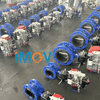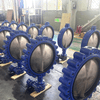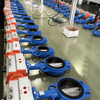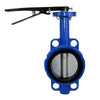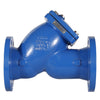Butterfly Valve Preferred Flow Direction: Why It Matters and How to Install
Why the Flow Direction of a Butterfly Valve Matters
Butterfly valves are compact, easy to operate, and widely used in water supply, HVAC, wastewater treatment, chemical systems, and many other industrial applications. Although many modern butterfly valves are designed with bidirectional sealing, engineers still recognize that there is usually a preferred flow direction.
Following the recommended flow direction doesn’t simply meet installation habits—it improves sealing performance, reduces operating torque, extends valve life, and helps prevent issues such as pump cavitation and fluid impact. Understanding the correct installation orientation is an essential part of proper system design and construction.
The Basic Principle Behind Butterfly Valve Flow Direction
A butterfly valve operates by rotating a disc through the valve stem to open or close the passage. As fluid enters the valve, pressure acts on both the disc and the seat.
-
Preferred Flow Direction:
When the valve is installed in the recommended orientation, fluid pressure pushes the disc toward the seat. This helps achieve a tighter shutoff and more reliable sealing performance. -
Reverse Flow Direction:
When fluid comes from the opposite direction, it tends to lift the disc slightly away from the seat. This increases the risk of leakage and can accelerate wear on the seat and sealing components.
Even though high-quality butterfly valves can generally handle pressure from either direction, following the manufacturer’s preferred flow direction provides clear benefits: longer seat life, reduced torque requirements, smoother operation, and fewer maintenance issues over time.
Why Is There a “Preferred Flow Direction”? — A Look Through the Lens of Eccentric Designs
To understand why butterfly valves often have a preferred flow direction, it helps to look at how modern high-performance butterfly valves are built. With the exception of traditional concentric (centerline) designs, most industrial butterfly valves today use double-offset or triple-offset geometry.
-
Double Offset:
The stem is offset from the disc center (first offset) and from the pipeline centerline (second offset). -
Triple Offset:
On top of the two offsets above, the sealing surface is machined into a conical angle (the third offset), creating a true “cam-action” closing movement.
These offsets aren’t random—they directly relate to how the valve interacts with the flow direction and are designed to optimize performance in real operating conditions.
1. Reduced Operating Torque
In the preferred flow direction, fluid pressure naturally helps lift the disc off the seat when the valve begins to open. This reduces friction at the critical moment when the disc breaks away from the seat, significantly lowering the required opening torque.
2. A True Non-Rubbing, Metal-to-Metal Seal
For double-offset and especially triple-offset valves, the closing motion is designed so that the disc only contacts the seat at the very end of travel.
In the preferred direction:
- The disc does not scrape the seat throughout its rotation.
- Wear is dramatically reduced.
- Once fully closed, system pressure pushes the disc tighter into the seat, creating a “pressure-assisted” or self-energizing seal.
The higher the pressure, the tighter the seal—provided the valve is installed in the correct flow direction.
3. Longer Service Life Under Tough Conditions
By minimizing friction, lowering torque requirements, and ensuring that fluid pressure assists rather than fights the sealing action, the eccentric design delivers:
- Less wear on the seat
- Less stress on the bearings
- Better protection for the disc and shaft
All of these benefits contribute to a noticeably longer service life, especially in demanding applications like high-cycle systems, abrasive fluids, or high differential pressure.

How Preferred Flow Direction Affects Installation
The preferred flow direction of a butterfly valve influences more than just sealing or operating torque—it also determines the correct installation orientation within a piping system.
In pump suction lines and general pipeline layouts, following the recommended flow direction and stem orientation is essential for maintaining stable flow, preventing cavitation, and avoiding unnecessary torque loads on the valve and pump.
In the sections below, we look at how butterfly valves should be positioned when installed upstream of a pump and how proper orientation contributes to a smoother and more reliable system.
Correct Installation of Butterfly Valves at Pump Suction
When a butterfly valve is placed on the suction side of a centrifugal pump, both the flow direction and the stem orientation directly influence the pump’s inlet conditions.
Poor installation can cause the disc to disturb the incoming flow, leading to turbulence, vibration, noise, and even a reduction in pump efficiency.
To ensure stable operation, the valve must be aligned with the pump shaft in a consistent manner.
Here is the general rule for proper installation:

✅ Correct Orientation
- If the pump shaft is vertical, the butterfly valve stem should also be vertical.
- If the pump shaft is horizontal, the valve stem should likewise remain horizontal.
Keeping the stem parallel to the pump shaft helps maintain a smoother approach flow into the impeller, reduces the chance of cavitation, and minimizes flow-induced forces acting on the disc.
Installing Butterfly Valves Near Elbows
When a butterfly valve is installed close to a piping elbow, the orientation of the stem and the location of the valve relative to the elbow have a major impact on fluid behavior and valve performance. The following three scenarios illustrate the typical outcomes:
✅ Best Practice: Install the Valve Upstream of the Elbow
Placing the valve before the elbow allows the incoming flow to be more evenly distributed across the disc.
This results in a stable flow field, smoother operation, and significantly less wear on the sealing surface.

✅ Acceptable: Downstream, with the Stem Parallel to the Elbow
If the valve must be installed after the elbow, keeping the stem parallel to the elbow helps minimize the uneven forces caused by the redirected flow.
This configuration reduces asymmetrical loading on the disc and keeps torque levels manageable.
❌ Incorrect: Downstream, with the Stem Perpendicular to the Elbow
Installing the valve downstream with the stem perpendicular to the elbow creates severe flow distortion.
The fluid strikes the disc unevenly, causing:
- High operating torque
- Excessive vibration
- Accelerated wear on the valve seat and bearings
In demanding systems, this poor orientation can dramatically shorten the valve’s service life.
Different butterfly valve designs have varying levels of sensitivity to flow direction. Regardless of whether the valve is concentric, double-offset, or triple-offset, the installation must always follow the flow arrow or flow indicator on the valve body.
Before installation, verify that the valve’s marking aligns with the intended direction of media flow.
If no marking is present, refer to the manufacturer’s technical documentation or consult the supplier. For eccentric designs, the geometry itself often provides clues to the correct flow orientation.
If you are selecting butterfly valves for water treatment plants, municipal distribution networks, industrial cooling loops, or HVAC systems, Union Valve is here to help.
Our technical team provides professional support, reliable products, and engineering experience to ensure your system operates with greater safety, stability, and long-term cost efficiency.
